The premise is simple: read one comic every day for the entire year. It seems like a simple task but there is no way that I read 365 comics last year, even if you count the individual issues in collections. So, this year, I am committing myself to this reading challenge, in the hope that I can broaden my reading habits and fully engage with my favorite hobby again.
This week, I’m looking at comics that have some kind of controversy attached to them: whether it’s linked to one of the creators, or the content of the comic. Obviously, this means that there may be some triggering aspects to this post, and the references made. Therefore, you may want to skip this week and come back next week when I’ll talk about some more wholesome comics.
At the end of last week, I looked at Shipwreck from AfterShock Comics, superbly drawn by Phil Hester, and written by Warren Ellis. Ellis was forced to face his disreputable actions when he was accused of sexual coercion and manipulation. The widespread accounts of his misdeeds and his seeming lack of accountability for his actions has led to the writer disappearing from the comic industry. However, his back catalog is still available, and his work is still visible in the history of the medium. Last week, I read one of his comics through the lens of hindsight, applying what we know now about the man to his art. This week, I intend to do something similar with a number of comics that, in one way or another, have links to controversies within the industry. The idea is to see if we can “love the art but hate the artist,” a question raised by Claire Dederer in her book Monsters: A Fan’s Dilemma, and also see if there is a legitimate reason to include these works in a continued discussion of comics.
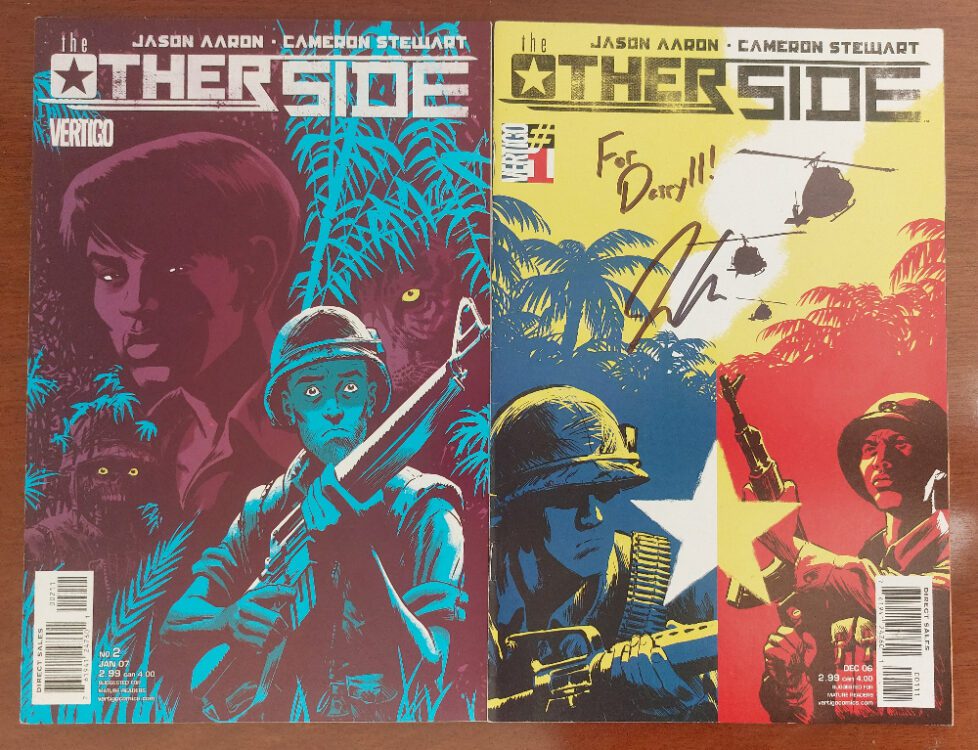
Credit: DC Vertigo
Comic Number 210: The Other Side #1-2
The Comic
In Jason Aaron’s tale of the Vietnam war, two soldiers tell their stories from conscription to battle. The hook here is that one is a young American bullied into the war, and the other is a member of the Viet Cong, manipulated by honor and his belief system.
From the outset, this is a violent comic that deals with the trauma and the consequences of war. Aaron sets the scene by referencing a number of pop cultural events over the top of a disturbing image, set in the forests of Vietnam. Both central characters are introduced to readers following scenes of death and destruction, foreshadowing their lives to come.
This is an engaging comic and is very well illustrated with a mix of over the top comical acting contrasting the disturbing, often grotesque, dream sequences. Both central characters become plagued by the war they are entering and their visions are vivid, brutal, and occasionally dark humored. In the first issue’s editorial, Jason Aaron refers to his cousin who was a veteran of the Vietnam war and wrote the short story that Full Metal Jacket was based on. There are similarities between the film and The Other Side, and the influence is clearly there in Aaron’s script. However, the artwork is more inline with the shock horror comics of the 1950s, some of which are referenced briefly throughout the comic.
The Controversy
The Other Side came out in 2006/2007. In 2020, the artist, Cameron Stewart, was accused of predatory sexual behavior and of grooming teenage girls. When the story broke, he was dropped by DC, where he had worked on Batgirl and Catwoman, two titles that had a large female fanbase. It also became apparent that his behavior was not news to many inside the industry. Stories surfaced of convention organizers warning potential victims against spending time with the artist, especially one on one.
Aside from the shock of the original allegations and the numerous stories that followed, was the fact that it didn’t seem to be surprising to a large number of people. There are also stories of Stewart moving cities to avoid the reputation that he earned.
The pattern of the news story was also nothing new in the industry: it followed a format similar to too many other stories. However, where the cases of Cameron Stewart and Warren Ellis differed, is that there was an instant negative reaction to the news that resulted in action being taken against the creators. In some past instances, the allegations were dismissed, overlooked, and down played. Some of the allegations didn’t even become news, instead lingering as bar room gossip until much later.
I previously looked at the way the allegations against Warren Ellis affected the way we read his work, but is the same true for an artist instead of a writer? The simple answer is, yes, but it can be more complex. Reading The Other Side in light of the Stewart allegations becomes harder on an emotional level. You maintain the knowledge of the artist’s personal life in the back of your mind, which means you are consciously looking for reflections of that within the work. With his work on a title like Catwoman, the process is easier than with a Vietnam-based war story like The Other Side. But the knowledge doesn’t go away, so we examine the work that much closer, which, as a result, pulls us further away from the story, engaging less. Even though Stewart is illustrating Aaron’s script without adding any biographical content, it is difficult to read his work without applying his personal behaviors to his visual representations.
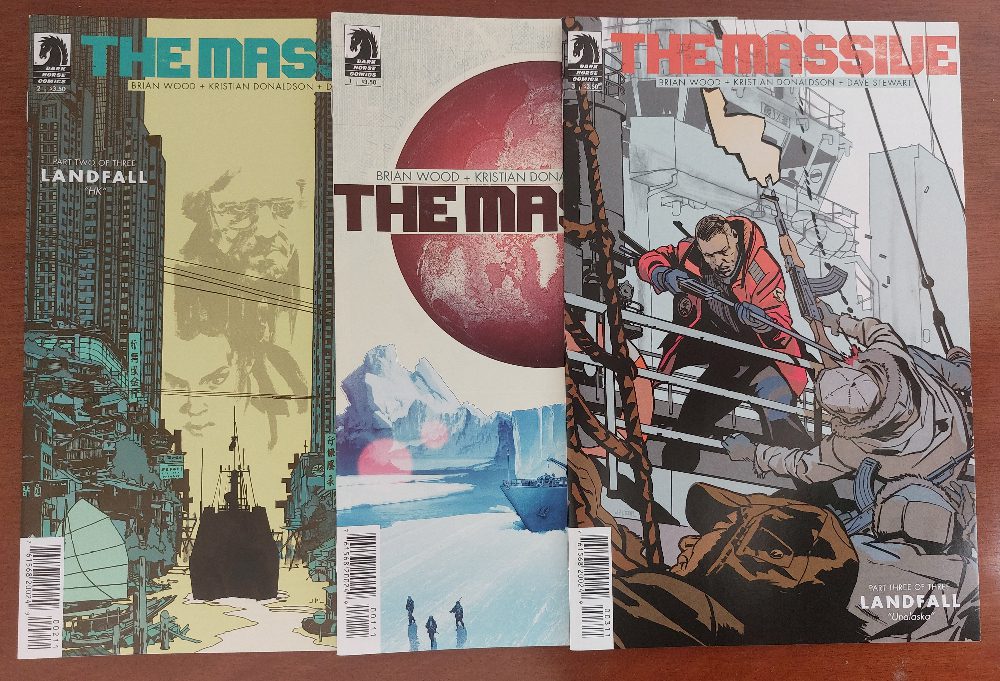
Credit: Dark Horse Comics
Comic Number 211: The Massive #1
The Comic
During a year-long event of natural disasters, the shape of the world’s nations changed forever. The oceans reclaimed much of the land and the majority of the survivors found themselves facing new challenges just to stay alive. The once environmentalist leader, Callum Israel, leads the crew of the Kapital on a search for their sister ship, The Massive, and finds that they are still fighting the same old fights against corruption and greed.
In the first arc, Landfall, the crew of the Kapital are introduced across two different time periods. The first sees them chasing down the Massive and trying to ward off relentless pirates. The second storyline is set just after the year of catastrophes, and begins to build the world that the rest of the series is set in. Across the first three issues, these two story threads set the scene and bring the reader into the world of Callum Israel and help to confront his personal dilemmas. It also lays out the environmentalist concerns of the writer and artists.
Artist Kristian Donaldson’s dramatic character work compliments the rigidness of the technology and vehicles that are integral to the comic. There is a real sense of machine versus nature with the human element trapped in the middle. Coupled with the color work of Dave Stewart, the narrative is clear even with the time jumps, and the reader can see a path being laid before the characters. As setups go, Landfall is perfect. It is the end of the world as we know it but not in a way we would expect.
The Controversy
For a while, The Massive was one of my favorite comics, however I don’t talk about it or recommend it to anyone. The simple reason is that the writer, Brian Wood, was accused of mistreating women. Initially in 2013, where he issued a dubious apology to one of his victims, and then again in 2019 when new allegations were made and previous ones repeated, this time forcing Dark Horse to cancel their future projects with Wood (I recommend this blog for details regarding the accusations and how they came about. It has plenty of links and references).
Unfortunately, the pattern of behavior associated with Wood and the way that the industry handled it, is one that seems all too familiar. As with the case of Cameron Stewart, people within the industry knew about the instances of mistreatment, but nothing was done about it. When accusations were made public, apologies and empty statements were made, excuses issued, and the whole thing was swept under the carpet (see this opinion piece on The Comics Journal website). Only when the story becomes too big, the number of women making complaints too high, or the accused becomes undefendable, is action taken within the industry.
With a writer like Brian Wood, the accusations seem to go against the work that he produces. His comics are full of strong, complex and independent women, just like in Joss Whedon’s work. Wood was the first to write an all female X-Men team and, using The Massive as an example, more often than not writes stories that revolve around a central female character, with her strengths and weaknesses pushing the story forward. The persona that Wood gives as a writer is contradictory to the accusations made of his personal life, just like Warren Ellis. Maybe because of the content of the work, it makes it harder to accept the reality of the creator. As readers, we want to respect the artists because we have so much faith and affection with the work: to accept that the artist is less than perfect is to ruin the art work. Once more the conversation returns to “the stain” that Deaderer talks about in her book.
If you go back and re-watch Whedon’s work, you can see a pattern of cruelty dished out to the female lead characters. Was that always there or are we reading into it after the fact? Are we looking for a different power dynamic in the work because we know of the creator’s behavior? The same can be done with Wood’s work. In The Massive, Mary is placed as central to the plot, an enigma to solve so that the greater narrative will make more sense. But is Mary actually a strong figure in the story or is she just a narrative device to be used, a puzzle to be solved? Once Callum can understand Mary, he will finally have control of her and the situation they find themselves in. By breaking her, solving the puzzle, he will become the dominant character and triumph. Or, am I reading too much into it?
I occasionally still read The Massive, but these days I approach it with different eyes, and a certain level of skepticism.
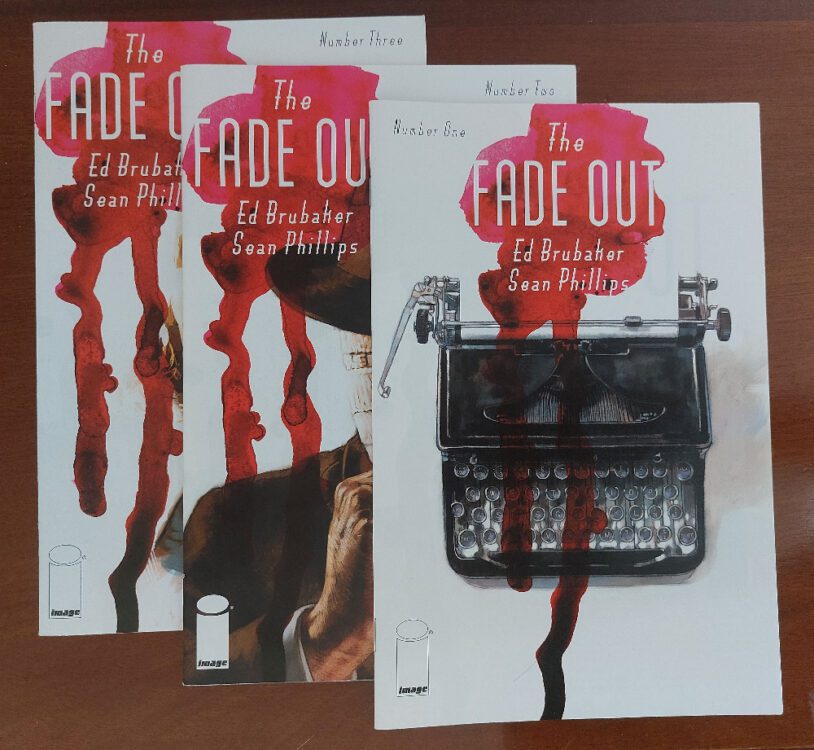
Credit: Image comics
Comic Number 212: The Fade Out #1-3
The Comic
From the superb creative team of Ed Brubaker and Sean Phillips, The Fade Out is a noir mystery set in mid 20th century Hollywood. It starts with the murder of an actress and a cover up by the company she is working for. The character, Charlie Parish, knows that there has been a cover up and his attempts to figure out why lead him into the murky Hollywood underworld. Corrupt law enforcement, unscrupulous producers, self-serving actors, alcoholic and drug using writers… this comic has them all.
The writing is tight and precise, just like all of Brubaker’s work. He focuses on character development while slowly creeping along the various plot threads. Phillips’ artwork sets the scene, fixing the action directly into the center of a bygone day Hollywood that is recognizable from classic movies. The art is atmospheric, illustrating hot dry nights, dingy backrooms, and glamorous producer parties filled with bright light and glitter, hiding a darkness underneath. These atmospheric highs and lows work so well because of the coloring provided by Elizabeth Breitweiser who worked with Brubaker/Phillips on Fatale as well as some of their Criminal comics.
The comic is steeped in unscrupulous people and actions. It focuses on the corruption of an industry and the consequences that atmosphere has on the people inhabiting it. Each of the single issues also comes with an essay about the real people of Hollywood from around the time the comic is set. These essays demonstrate that the comic isn’t mere fantasy and the debris of searching for fame litters the streets and graveyards of tinsel town.
The Controversy
We could also title this part as “the dangers of association.” The Fade Out is a comic about corruption and generally unlikable people, and — while the writer and artist have not been involved in any controversy — the colorist on this title has. Elizabeth Breitweiser is an excellent colorist who has worked for most of the major publishers on some of the biggest titles. Her work in The Fade Out and Fatale was perfect for setting the scene and atmosphere of both comics. In 2019, she and her husband set up their own independent publishing company, Allegiance Arts & Entertainment. However, in the year before, the Breitweisers were embroiled in an online altercation between creators in mainstream comics and those associated with a particular outspoken, often referred to as a hate group, comic organization: Comicsgate.
The problem started with a tweet from Mitch Breitweiser seemingly supportive of Donald Trump’s winning of the American Presidency. This resulted in a string of comments from those, mostly working for the mainstream, disagreeing with the sentiment while a section of right-wing creators shouted support. As the Breitweisers adopted a ‘be friendly to everyone’ attitude at first (they had a crowdfunding project to promote), they began to receive endorsements from the Comicsgate crowd. Because neither Elizabeth or Mitch spoke out against the organization, they were seen to be a part of it. This led to a bit of a backlash, and forced the couple to pull out of a comic convention appearance at the Lakes International Art Festival in the UK due to safety concerns.
It is also at this point that Elizabeth stopped working on comics for the main publishers. In the following year, they launched Allegiance Arts & Entertainment, publishing and distributing their own comics with an initial contract to have them stocked in Walmart.
The most curious aspect of this story is that there is very little evidence to show whether the creators were supporters of any comic organization or if they were victims of turbulent times. Most available news stories about the incident come from unreliable online news outlets. Other articles, such as the one from Arkansas Times about the launch of their company, address the issues but suggest that the Breitweisers wanted nothing to do with any of the arguments, and stepped away from an industry that they saw as failing the fans.
Allegiance Arts & Entertainment are still producing comics but with very little fanfare online. They have small announcements of new books and are occasionally featured on ‘comics to avoid’ features due to the perceived past allegiances. However, it is very difficult to find anything online about the controversy surrounding Elizabeth Breitweiser because the accounts on Twitter and elsewhere where it played out have been deleted. We know that she completed her work on the Kill or be Killed title with Brubaker and Phillips but then did not return to any of the mainstream comics where she made her name.
In a society where careers can be made or broken on social media, public promotion and interactions become a rocky ground that is difficult to traverse. Often, saying nothing is the best course of action, however, as the central character in The Fade Out discovers, that can be just as problematic as speaking out. Just like Cameron Stewart in The Other Side, you can’t see Elizabeth Breitweiser’s controversy that surrounded her and her husband directly in her coloring work, but just like in the comic, there is clearly more to uncover below the surface.
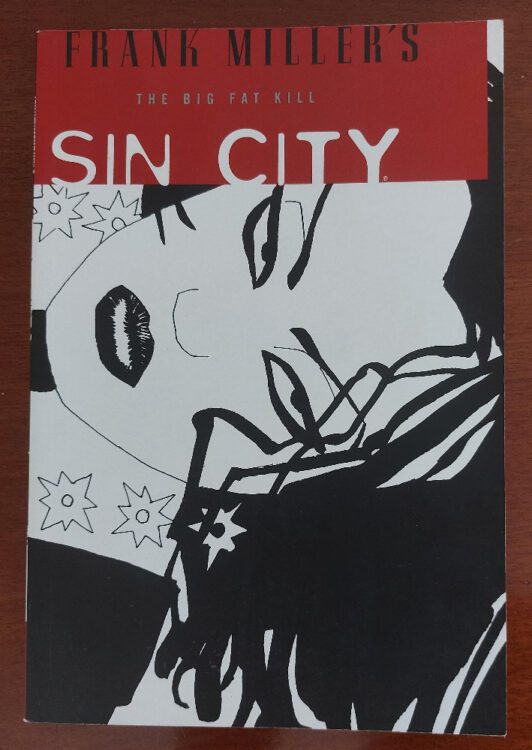
Credit: Dark Horse Comics
Comic Number 213: Sin City: The Big Fat Kill
The Comic
Most people will be familiar with Frank Miller’s Sin City series, if for no other reason than it was adapted into a popular, stylistic movie with an all-star cast in 2005. The movie takes several stories from the comic book series and merges them together in an anthology style narrative. In The Big Fat Kill, Dwight comes to the defense of his girlfriend, Shellie, who is being harassed by a former lover. Being Frank Miller, this leads to some excessive violence and a few tragic turns of events. The story deals with police corruption and brutality, organized crime families fighting over territorial rights, and the abuse of women in many forms.
Miller has a unique artistic style, especially in the Sin City comics. Solid black shadows create negative space from which the images emerge, a reflection of the harsh black and white morals of most of the characters. There is a simple right or wrong approach to the characterization which is complicated by the nature of the story. If you, as a reader, can’t buy into the simplification of morals then this book is difficult to read. But this simplification also complicates other aspects of the comic.
The depiction and treatment of women in this comic is a source of contention. Miller hypersexualizes the female characters and, more often than not, makes them victims — even the ones who on first appearance seem strong willed and independent. There is always a hero coming to rescue the damsel. There are also other visuals that can be misconstrued or incorrectly interpreted, such as the swastika throwing stars.
The Controversy
Despite the violence and questionable treatment of women in the Sin City series, it is not the comic itself that is surrounded with controversy, but the creator. In some respects, we might have been better looking at Frank Miller’s Holy Terror, because that’s one of the more controversial of his titles. However, I do not own it, therefore was unable to include it here.
It was with the release of Holy Terror, and some of the online statements that Miller made, that began the vocal backlash against his work. In 2011, when Holy Terror was released, Miller made various outspoken statements on his online blog, one of which attacked the Occupy Movement. This earned him a response from Alan Moore who labeled Millers work as “misogynistic, homophobic and misguided.” There were also accusations of Islamophobia with the release of Holy Terror which led to fans and creators to boycott conventions where the writer was due to appear. In 2021, the popular Thought Bubble convention in Leeds, UK reversed a decision to include Miller as a guest due to backlash on social media.
Unlike some of the other creators I have written about, the controversy surrounding Miller has not ended his career, or even slowed it down. Miller continues to produce work that both excites and offends the industry, depending on where you stand. His work has always been challenging, and he has never shied away from his opinions. Holy Terror might be too close to the bone for some people, but his work has never been easy or agreeable. Where excessive violence has usually been a part of his comic work, the treatment of women and religion has always been questionable. On occasion, the work could be seen as satire or a reflection and judgment on the mass media entertainment as a whole, but this is not always clear and, combined with his online comments, Miller has managed to cause offense.
How is it that one creator can cause offense and effectively be removed form the industry while another can maintain their standing? Part of it may come down to the initial standing that someone like Frank Miller has. He was one of the voices that revolutionized modern superhero comics with a style and substance that was always controversial. His work was also beloved by the comic-reading fans who, in the late 1980s, didn’t have as much access to biographical information about writers and artist. The 1980s superhero comics also had a much different, less diverse, readership than today. The fans didn’t care about the creators’ politics, and as a result, the publishers didn’t either.
Once that reputation has been built, it is difficult to break down, especially when a lot of the original fans are still buying the comics. Take Stan Lee as another example: seen as the father of modern comics by some, his reputation has been challenged on a number of occasions (as evidenced in this review of a book about the publisher) but his standing within the industry hasn’t changed. It would take more than disagreeable opinions to alter the way people interact with these creators’ comics. And that is another difference between Miller’s situation and that of someone like Brian Wood: the controversy boils down to words and opinions, not actions. Although objectionable, Miller’s views are just that, personal opinions. It is possible to pass judgement on someone for their opinions, but it is harder to implement a punishment. Should art be reserved only for the people whose opinions are currently acceptable by the majority? It is understandable that some people would not want to work with Miller, or even be included in the same event, but it becomes harder for organizers and publishers to disassociate themselves on the grounds of personal opinion.
The notion of association comes up again here; any publisher must weigh up the costs of associating with outspoken creators. In the Thought Bubble/Miller incident, the organizers of the convention believed that taking the creator off of the guest list was the best action for their convention. Thought Bubble is a very diverse convention, championing small press and diverse creators, and the inclusion of Miller would definitely harm the convention’s reputation. Other events might not feel affected in the same way.
When we read comics, we take many things from them. Some of those things we may find disagreeable, and we may relate those views to the creator, but that does not mean that we should revoke their right to create comics. We have a choice, as readers and as consumers. We can decide not to engage with certain creators, publishers, and events, just as they have a choice who they work with and how they promote their brand.
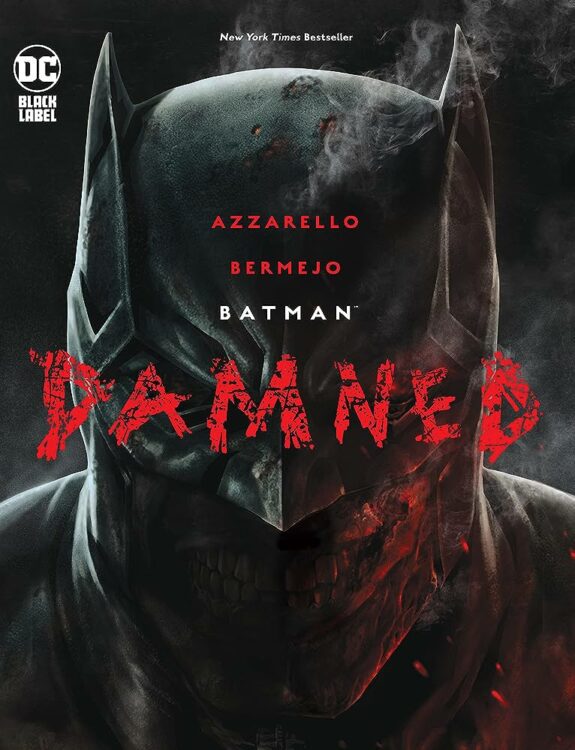
Credit: DC
Comic Number 214: Batman: Damned #1
The Comic
Lee Bermejo draws Batman’s penis. It may be in the shadows, but its shape can be defined.
There is more to the comic, but this is the only aspect anyone talks about when discussing Damned, which is itself a review of the comic. Even after the comic was reissued with heavy shadows replacing the offending member, this comic will only ever be known as the one with Batman’s penis.
The Controversy
The problem is obvious. There was outrage that Batman was drawn fully naked with his penis visible in several panels. Batman: Damned was the first release of DC’s Black Label, a new imprint aimed at a more mature audience. However, the audience wasn’t apparently mature enough for naked Bruce Wayne. Online media was quick to jump on the comic and a host of jokes was posted across Twitter.
What is surprising about this is how fast DC decided to edit out the offending member. The digital edition featured edited pages and all subsequent printings would match the digital version, thus removing any reason to buy the comic in the first place. The main problem here is: why did DC do this? A cynical person might say that it was released in this way to generate a story and make the first issue of Batman: Damned a collector’s item from day one. However, the whole situation highlights a sexist attitude towards mainstream comic production. Other than Doctor Manhattan in Watchmen, there are no notable examples of a penis in mainstream superhero comics. There are, however, plenty of examples of naked, or virtually naked, female characters. In fact, most of the female superhero’s outfits barely cover their bodies. The controversy isn’t really that DC included a few panels of the barely visible Bat-Penis but the fact that it was an outrage and a newsworthy story, while the treatment of the female characters is still so poor.
In the grand scheme of things, is this even controversial?
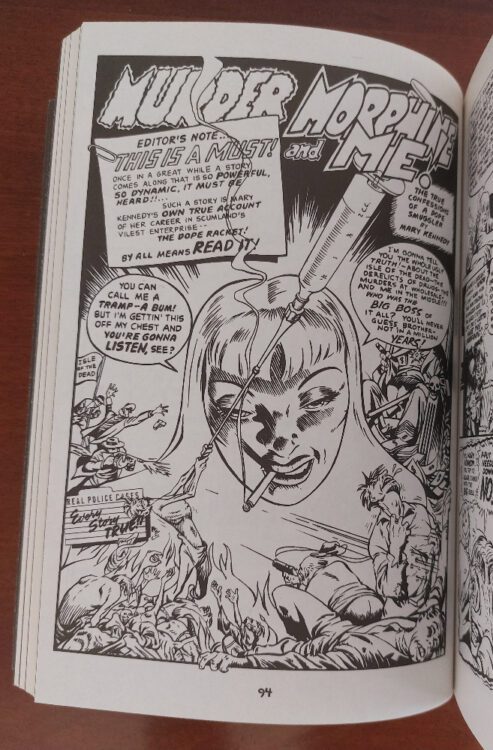
Reprinted in The Mammoth Book of Best Crime Comics by Robinson
Comic Number 215: Murder, Morphine, and Me by Jack Cole
The Comic
Originally published in True Crime Comics #2 in 1947, the 14-page comic is, in some ways, typical of the period and features all of the cliches of crime comics. It has gangsters, molls, shoot outs, and punishments for all. Printed under a ‘True Story’ banner, to add legitimacy and greater impact to the disturbing story, the tale is a confession of a female drug dealer who fell in with the wrong crowd and, before she knew what was going on, she was in too deep.
The basic story itself is nothing new, not even in 1947, however, the way that it is told and the artwork by Jack Cole marks the comic out from the deluge of crime stories from the time. Cole’s artwork is visceral and disturbing. He fills the panels with immediacy of action that heightens the threat level of every scene. Some of the images are simply upsetting, stomach churning even, while others are discomforting and disorientating. Cole gets under the skin of Mary Kennedy, the central character, and makes her empathetic, an aspect often missing from the crime comics where the shock value is greater than the characters.
The Controversy
It might seem obvious where the controversy is around this particular comic: the contents are hard-hitting, even by today’s standards. However, Cole’s tale has closer links to the 1950’s comic book scare than most because Dr. Fredrik Wertham specifically referenced one of the panels in his book The Seduction of the Innocent. The panel in question (although not credited in Wertham’s book) is the first panel on the last row of page two. In it, the central character has a hand straddling her face, forcing her eye open, while the unseen assailant thrusts a needle towards her eyeball. The off-kilter border with a wavy frame, distinct on the page, emphasizes the horrific moment while the large, bold text stamps home the terror Mary is feeling.
It is well documented that Wertham was calling for the regulation of comics, deeming many to be unsuitable for the audience that it was either intended for, or who were able to read it. He has also been made a villain in the history of comics. However, in the discussion regarding this particular comic, Wertham makes a good point about appropriateness. The image of a needle almost piercing a woman’s eye is not just disturbing, it has a number of other connotations, especially in regards to violence against women.
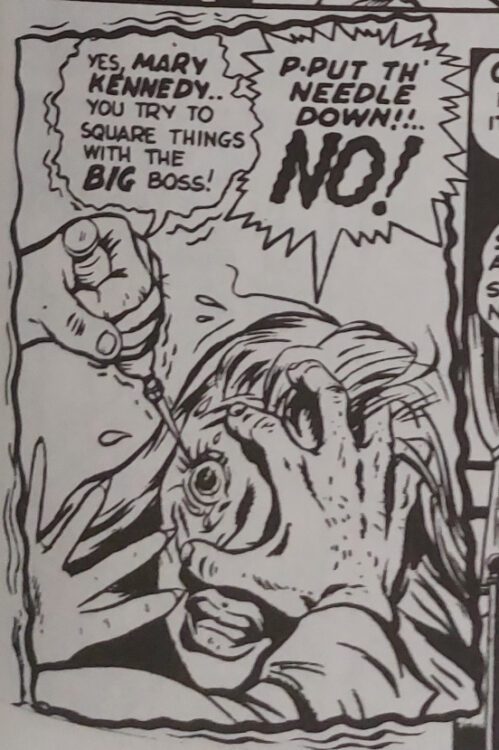
The offending Panel from page 2 of the comic
In an email discussion between Craig Fisher and Bart Beaty about Fredric Wertham, Beaty proposes the fact that in this instance, Wertham might be right in his concerns. In response to a comment made by Art Spiegelman comparing Murder, Morphine, and Me to Salvador Dali’s Un Chien Andalou, Beaty says:
“By equating Cole’s work to a masterpiece of high cinematic modernism, Spiegelman suggests that the two should be accorded the same respect and seriousness. But Un Chien Andalou circulated in theatres clearly designated as adult spaces, while Cole’s work was made available to children as its primary market (as is evidenced by its price). Wertham’s argument would be that neither of these things were appropriate for children, and, in his efforts to elevate Cole for a New Yorker audience, Spiegelman seems to imply the same”
When True Crime Comics #2 was released, it was easily accessible by anyone with 5 cents. Even though there was a large adult readership, children were, more often than not, the target audience for these comics. To equate the comic to a modern medium, would you allow a pre-teen to watch the infamous eye scenes from A Clockwork Orange, or Zombie Apocalypse? Scenes in both movies contain a similar visual as the panel from this comic and both are disturbing beyond the obvious visual discomfort. The question raised here is about accessibility and appropriateness. If this comic was released into today’s direct market there would not be a problem, but would the same be true if it was placed in a newsagent or supermarket next to the LEGO and Minecraft magazines?

Comic Number 216: Zap Comix #1
The Comic
The banner at the top of Zap Comix #1 reads “For Adult Intellectuals Only.” It is a humor magazine, packed with obscenities, crude artwork, and vulgar gag comics. There is nothing subtle about this underground comic from 1968, and the main artist, Robert Crumb, is an infamous figure in comics history.
In an rebellious act against the restraints of mainstream comics, the underground movement was born out of a hippy-esq counter culture that wanted to create art in many forms. The production and sale of comics, such as Zap Comix, was a low key affair but the notoriety of someone like Crumb made Zap Comix, and the anthologies that followed, sufficiently big hits.
Modern readers may find Zap Comix a hard read because of the casual sexist and racist commentary and visuals. Crumb did not hold back and poured the darker parts of his psyche onto the pages. Obscenities fly across the panels and are mixed in with the type of school yard gags that made MAD magazine such a hit. There is a lot of good cartooning in the comic but it hasn’t become very well known due to the offense it caused, and the grotesqueness of the jokes and the treatment of the women throughout Crumb’s work does not make for easy reading.
The Controversy
Robert Crumb was a massive influence on underground comix, and it is no surprise that 1968 is often cited as the starting point for the movement because that is when Zap Comix #1 was released. As Roger Sabin has noted, “Zap stands as one of the most important titles in comics history” (from Comics Studies: A Guidebook). Crumb has been hailed as a genius, a forerunner for many modern comic genres, including autobiographical, and his work has been revered in exhibitions and numerous collections.
He was also extremely racist and sexist both on and off the page. Feminist writer Deirdre English and fellow cartoonist Trina Robbins both spoke publicly about the abusive and often violent attitude that Crumb had towards women. Crumb himself admitted that he had a problem. And despite this, his work is openly studied and discussed in academia and all forms of comic journalism. In 2022, a contemporary art gallery in France held an exhibition of his work to celebrate his style and contribution to comics history.
Why does this occur? Why is someone like R Crumb revered so much by the community despite the fact he behaved so badly? One of the reasons might be because he was part of a counter culture operating outside of the mainstream. The position he held is seen as being different to a staff writer at Marvel of DC. He has been placed on a pedestal, raised to the position of Artist with a capital A, instead of comics illustrator. As such we, the community, allow him special dispensation.
Or maybe it is because he owns his behavior and admits the mistakes he has made. But, in reality, is he any different to Warren Ellis or Brian Wood? Robert Crumb made a sizable contribution to the history and evolution of comics, but does this mean that the stain of his reputation is smaller, harder to see?
I don’t have an answer. I think that everyone should be held accountable for their actions, but I also understand the requirement to study the work that shapes the history of comics. Without people like Robert Crumb, the comic landscape might be very different. However, that does not mean that I endorse his behavior or would promote his work.
Looking at controversial comics and creators is difficult. The pattern of abuse by men in the industry is alarming, but almost as shocking is the number of times people get away with disgraceful behavior because of their position or bankability. There are, also, levels of controversy, with someone’s political opinions being of less importance than abusive and grooming actions. But, of course, in our age of instant media, anything that someone says can be used for or against the person saying it, making or breaking careers in the process. This is the reason why we should not shy away from these topics and discuss them openly. It allows the control to be taken away from heated arguments on places like Twitter, and for real action to be taken, as in the Warren Ellis case. After the storm on Twitter, those affected took control and set up a space for reasonable discussion and care to take place. The somanyofus.com website became a place for the victims to make a stand and own what had happened to them without persecution from social media bullies.
I love comics and I love the history of comics culture. Unfortunately, saying that means that, on occasions, I have to deal with unsavory topics or creators.
From next week, I will move on, and pick out some easy reading, wholesome comics to counter the last two, difficult weeks.

